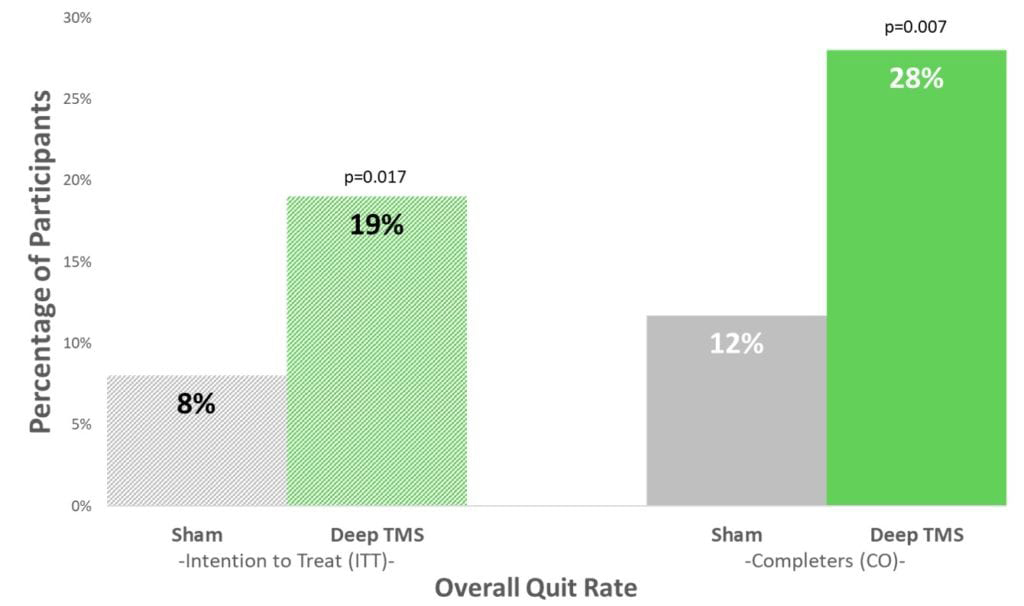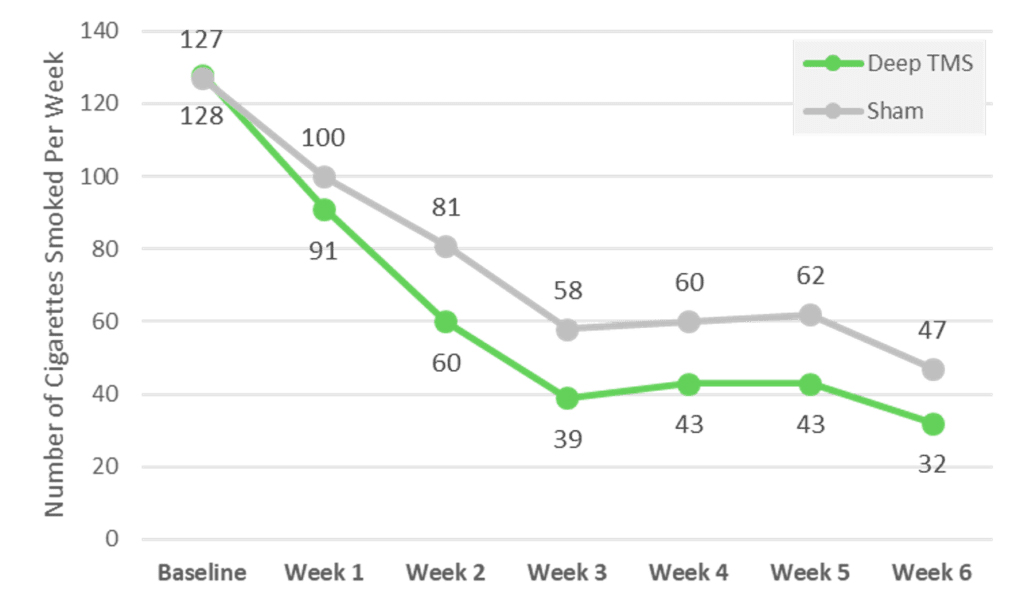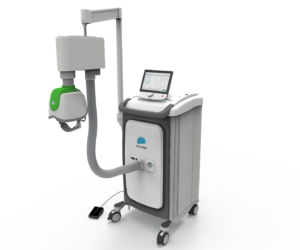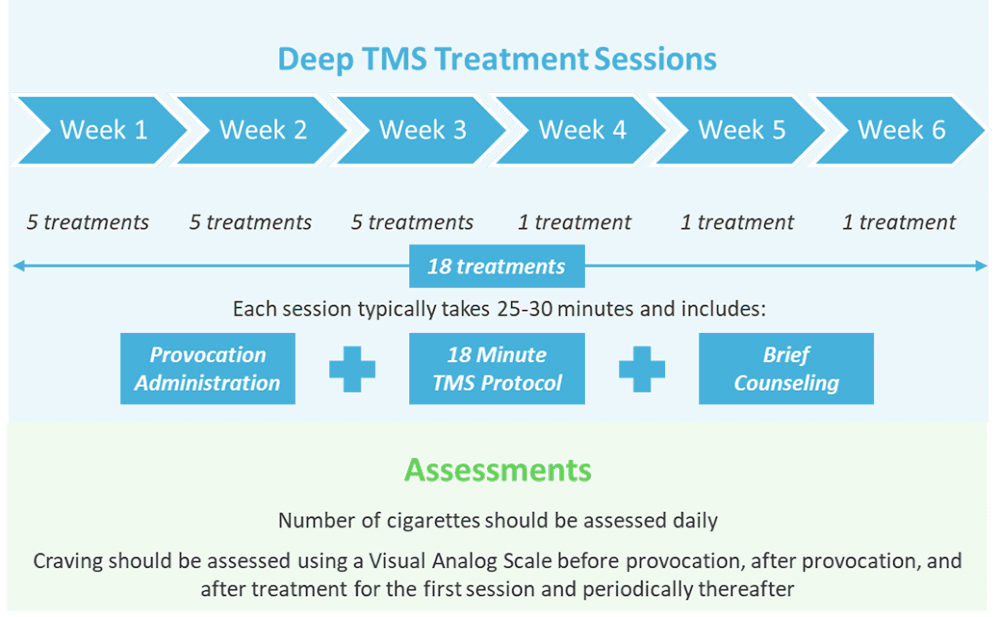TMS for hard-to-treat smoking
Smoking is one of the leading causes of preventable death. According to the Centers for Disease Control and Prevention (CDC), about 480,000 Americans die every year because of tobacco products. Smoking can be one of the most difficult habits to stop. People try everything from nicotine patches to hypnotherapy, but still fail.
The Advanced TMS Center is offering one of the most effective new tools: TMS therapy for smoking.
Studies have shown TMS (transcranial magnetic stimulation) is effective for people who have a long history of smoking and have experienced multiple failed attempts to quit. TMS therapy for smoking helps by reducing nicotine craving.
TMS Therapy for Smoking Can Help You in Ladera Ranch - Mission Viejo, CA
During TMS therapy for smoking, a metal helmet is placed on a patient's head while the patient is sitting. A magnetic coil inside the helmet gently sends magnetic stimulation to parts of the brain that cause cravings and dependence. It is believed that addiction may be caused by an imbalance at the cellular level. TMS therapy equalizes this imbalance.
The National Center for Biotechnological Innovation noted a study that showed a 33% success rate after six months of TMS therapy for smoking.Medscape reported on a study that had a 50% abstinence rate.
TMS therapy for smoking can also be used with cognitive-behavioral therapy (CBT) to help people stop smoking.
TMS therapy for smoking is an outpatient procedure, which does not require hospitalization or anesthesia. You can drive yourself to and from the Advanced TMS Center. You can even go back to work, if you choose to. This is not electroconvulsive therapy (ECT), and does not cause harmful side effects such as memory loss.
Learn More About TMS Therapy for Smoking in Ladera Ranch - Mission Viejo, CA
Quitting smoking is one of the hardest things to do, but the good news is you are not alone. The Advanced TMS Center is here to partner with you, and help you through this life-changing effort. You can literally add years to your life by quitting, and we have the high-tech solution to help.
To learn more about TMS therapy for smoking, call the Advanced TMS Center at . Our medical staff can answer your questions, and help you with a scientifically-proven treatment that treats the area of addiction.
Smoking addiction, otherwise known as nicotine dependence, has been plaguing humanity throughout history. The detrimental effects of this form of addiction are well-documented, but the biological, genetic, and social draws of this activity continue to take a toll on individuals across the globe. That said, our current battle against COVID-19 has provided many nicotine addicts with the incentive they needed to finally kick the habit - though it remains an uphill battle.
Smoking Addiction Definition
Smoking and more specifically nicotine addiction are defined as the compulsion to inhale the stimulant nicotine, which is commonly found in cigars and cigarettes. Nicotine produces a pleasurable fleeting feeling that causes the desire to smoke more frequently, thus creating a cycle of addiction.
Nicotine comes in different forms: it can be chewed raw, pre rolled as cigars or cigarettes, loose tobacco for rolling cigarettes or smoking with a pipe, smoked through a hookah or water pipe, or with a vaporizer, or e-cigarette which deliver nicotine through an atomized liquid, or traditional tobacco leaves.
About 45 million Americans are considered smokers. A third of all individuals who try smoking tobacco, even once, become daily smokers. Out of the smokers who try to quit, less than 5% are successful. Tobacco causes roughly 8 million deaths a year, from cancer, cardiovascular illness, lung disorders, diabetes and more.
Contributing Factors to Smoking Addiction
As the active ingredient in tobacco, nicotine, binds with nicotinic cholinergic receptors in the brain. This causes the release of acetylcholine, a mood-elevating neurotransmitter that causes a brief euphoric sensation. Following repeated use, one's brain starts to seek out the rewarding experience created by nicotine binding, making them increase how often they use it.
In addition to the above-mentioned biological factors, a genetic tendency toward addiction also exists, making some individuals more prone to nicotine dependence than others.
A third significant factor is the social aspect: many smokers are introduced to smoking within a social setting and continue smoking until they develop an addiction due to social pressures and a desire to fit in.
Smoking Under COVID-19
The World Health Organization (WHO) has highlighted a clear connection between smoking and developing serious symptoms due to COVID-19 or the coronavirus. This is due to the disease primarily attacking the patient's lungs, with severe cases causing serious respiratory difficulties and in the most extreme cases, mortality. Fortunately, many smokers have been taking all this to heart, quitting smoking at record-breaking numbers. In the UK, for instance, more than 300,000 smoking addicts have reportedly kicked the habit due to concerns over COVID-19. In addition, over 2.4 million smokers have reportedly cut down on their smoking over corona-related concerns. Overall, smoking cessation numbers are reported to be the highest they have been in a decade, with many ex-smokers attributing their decision to quit to the current pandemic.
New Hope for Smoking Cessation
Deep TMS has been recognized as a safe and effective treatment for smoking cessation assistance, being FDA-cleared in August 2020. Deep TMS works by projecting electromagnetic pulses that help regulate the neural activity of brain structures associated with smoking addiction. This non-invasive treatment does not cause any significant or long-lasting side effects, can be combined with any other form of treatment, and can be integrated into patients' daily routine.
The above-mentioned recognition is the latest addition to Deep TMS's FDA clearance status for major depressive disorder (MDD) from 2013 and obsessive-compulsive disorder (OCD) in 2018. Additional Treatments for Smoking Cessation
Several other safe and efficient smoking cessation treatments are available today. Among them are:
Nicotine replacement products: These include patches, lozenges, gum, sprays, and inhalers. These products provide a steady flow of nicotine to the brain while avoiding smoking and smoke inhalation, assisting with withdrawal symptoms and its accompanying cravings.
Nicotine-Free Medication for Smoking Cessation: These prescription medications can also assist with the process of withdrawal. A common drug prescribed for assisting in smoking cessation is called Bupropion, which also helps against symptoms of depression. A second drug, called Varenicline, works to alleviate smoking dependence by blocking nicotine receptors in the brain.
Introducing BrainsWay Deep TMS for Smoking Cessation
BrainsWay Deep Transcranial Magnetic Stimulation (Deep TMS) is a safe and effective aid for short-term smoking cessation in adults, representing the first FDA clearance in the addiction space for any TMS device.
Using BrainsWay's patented H4-coil, the treatment generates electromagnetic pulses that stimulate neurons in brain structures associated with addiction - specifically the bilateral insula and prefrontal cortex. BrainsWay Deep TMS is proven to reach wider and deeper brain regions than traditional TMS devices.
A double-blind, sham-controlled, multicenter randomized controlled trial of 262 patients found Deep TMS to be an effective treatment, significantly improving the continuous quit rate, reducing craving and the average number of cigarettes smoked per week. Participants in the study were highly addicted to smoking, with a history of smoking an average of over 26 years and multiple failed attempts to quit.
Deep TMS is a well-tolerated, non-invasive treatment with no systemic side effects. It does not require a significant recovery period, and the 18-min treatment can easily be integrated into each patient's day-to-day schedule.
Smoking Addiction: Key Points
Tobacco smoking is one of the leading causes of preventable disease and death throughout the world, with 34.2 million U.S. adults smoking cigarettes and approximately 480,000 dying each year (about 1 in 5 deaths). While the percentage of Americans who smoke cigarettes has declined over the past several decades in part thanks to various impactful public health initiatives, tobacco addiction continues to be a significant health concern, with more than 16 million living with a smoking-related disease, such as lung cancer and heart failure.
Addiction to nicotine, similar to addiction to drugs and alcohol, is characterized by intense craving, compulsive use, and an inability to stop despite negative consequences. Areas of the brain involved in decision-making and behavioral control are impacted, and smokers build a tolerance, requiring increasing levels of nicotine to achieve the same neurotransmitter release that triggers pleasure. In addition to health problems associated with nicotine addiction, smokers can also suffer from withdrawal symptoms when trying to stop and reduced participation in social situations where smoking is not allowed.
Smoking Addiction Demographics: According to the CDC, men are more likely than women to be cigarette smokers (15.6% vs. 12.0%). Smoking is more prevalent among individuals with lower household income and lower degrees of education. Adults experiencing psychological stress have also been shown to smoke at nearly triple the rate of those not experiencing psychological stress.
Possible Cause for Smoking Addiction: Factors that increase the likelihood of nicotine addiction include younger age at which the individual begins smoking, genetic inheritance, individuals who grow up with parents who smoke, and other substance abuse. In addition, numerous studies have demonstrated an association between smoking and mental illness, including depression and PTSD.
Treatment Options in Your Battle Against Smoking Addiction
Several treatments have been developed to treat smoking addiction, many of which have been found to be effective in combination. Deep TMS: Deep TMS is the only non-invasive medical device FDA-cleared for short-term smoking cessation. It uses electromagnetic pulses to stimulate neurons in the bilateral insula and prefrontal cortex, reducing tobacco cravings and increasing cognitive control. A double-blind, multi-center, randomized, controlled pivotal study of 262 subjects demonstrated a significant improvement in the continuous quit rate, as well as a substantial reduction in cravings and number of cigarettes smoked. Deep TMS has been shown to be well-tolerated, causing no systemic side effects, and can easily be incorporated into the patient's daily routine.
Psychopharmacology: Two medications, Buproprion (Zyban) and Varenicline (Chantix), over a 7-12 week course of treatment, have been FDA-approved to treat smoking addiction. Buproprion inhibits the reuptake of norepinephrine and dopamine, thereby increasing their synaptic availability, while Varenicline blocks nicotine receptors. Medication for smoking cessation present potential side effects, including nausea, sleeplessness, and rare seizures, particularly for patients who drink alcohol while taking the drug.
Nicotine Replacement Therapy: A variety of over-the-counter NRTs are available, includes gums, sprays, patches, and lozenges. These treatments provide small amounts of nicotine, helping the quitting smoker cut down on cravings and ease symptoms of withdrawal. NRTs have been shown to be more effective when paired with counseling programs. Possible side effects include skin irritation, dizziness, headache, racing heartbeat, and rarely nicotine overdose.
Psychotherapy: Counseling helps smokers develop the skills, behavioral and mental patterns needed to cease addiction to tobacco. Several forms of psychotherapy have been shown in clinical studies to be effective for smoking addiction. Cognitive Behavioral Therapy (CBT) helps smokers identify triggers and teaches coping strategies when presented with those triggers. Motivational Interviewing (MI) helps smokers understand their reluctance to quit and improves motivation to live a healthy lifestyle. Mindfulness teaches smokers to become aware of cravings and reframe them as tolerable.
Lifestyle Changes to Protect Against Smoking Addiction: In addiction to medical treatments, improvements to diet, exercise, and avoiding smokers have been shown to contribute to cessation. Note that e-cigarettes have not been proven to be safe or effective for smoking cessation, and patients attempting to quit should avoid substituting other forms of tobacco.
Deep TMS Efficacy in Treating Smoking Addiction
BrainsWay's Deep TMS treatment using the H4-coil aids in short-term smoking cessation, as demonstrated by data obtained in BrainsWay's multicenter, double-blind, randomized controlled pivotal study. Participants in the study were highly addicted to smoking, with a history of smoking on average for over 26 years and multiple failed attempts to quit.
The study demonstrated that among participants that completed treatment, the continuous quit rate, referring to four consecutive weeks of abstinence from smoking, was 28.0% in the active Deep TMS treatment group compared to 11.7% in the sham treatment group. Weekly abstinence was self-reported by participants and corroborated through urine tests.


In addition, the difference in the average number of cigarettes smoked per day per subject from baseline to the end of the study (4-month follow-up for quitters and 6 weeks follow-up for smokers) was statistically significantly lower in the active Deep TMS group compared to the sham group.
Deep TMS as a Safe Treatment for Smoking Addiction

Deep TMS treatment for short-term smoking cessation is non-invasive, requiring no anesthesia, does not cause any significant systemic side effects, and can easily be incorporated into the patient's routine.
In the pivotal clinical study, Deep TMS was shown to be well-tolerated. The most common side effect reported was headache, primarily during the first treatment sessions (24% of those in the active treatment group and 18% in the sham group). No seizures were observed. Deep TMS Treatment Protocol
BrainsWay's Deep TMS for Smoking Cessation consists of a patented H-Coil, held inside a cushioned helmet fitted onto the patient's head. When activated, the H-Coil produces repetitive magnetic pulses that regulate the brain's neural activity.
Deep TMS sessions for short-term smoking cessation consists of a brief provocation designed to activate the relevant brain circuitry, an 18-minute TMS treatment, and brief counseling. A full course of BrainsWay Smoking Cessation typically requires three weeks of daily treatments, followed by one treatment per week for three additional weeks (18 sessions total over six weeks).
The target quit date should be set within the first 2 weeks of treatment. Many patients stop smoking within the acute phase of treatment, with the remaining treatments helping maintain the effect.








